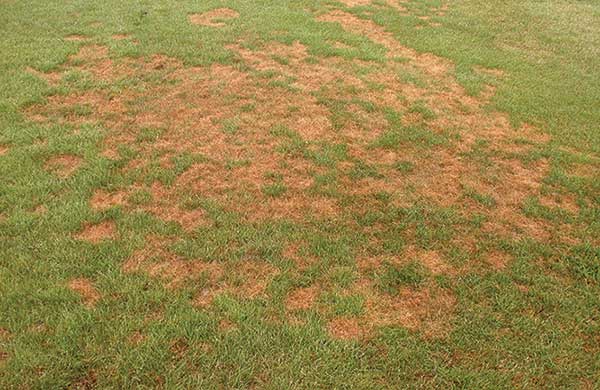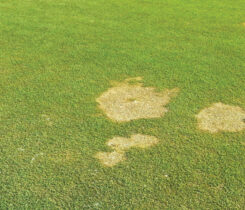Revisiting the research projects we highlighted in 2023
As 2023 winds to a close, it’s time to look back at the list of great research articles we logged for Golfdom this year. We’d like to thank all the authors for working closely with us to bring you the results of their outstanding research.
What I like about our digital world is that you can click on the title of an article and have it up in seconds. I hope this has been a great year for you all, and we wish you all the best in 2024!
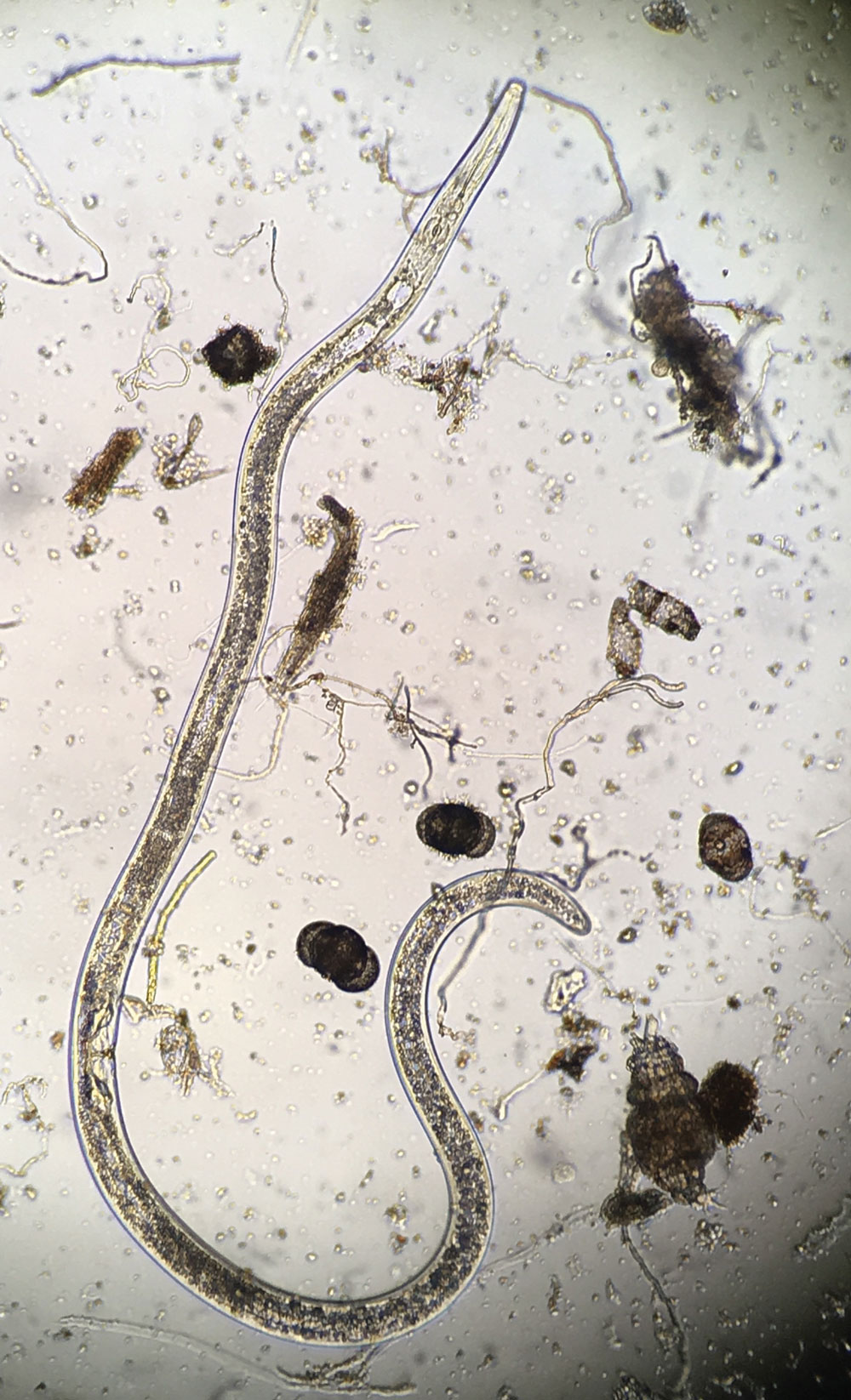
Belonolaimus longicaudatus (sting nematode) is a large nematode, reaching sizes of about 1/8-inch long when mature. (Photo: Bruce Martin)
January: A close look at the impact of golf courses on pond ecosystems
By Joseph Milanovich, Ph.D., and Martin Berg, Ph.D.
- Concentrations of analytes (fungicides, insecticides and herbicides) measured in golf course ponds were low and infrequently detected for 8/10 analytes examined. Azoxystrobin, a fungicide, was the most widespread analyte measured and tested in mesocosm experiments.
- Amphibian diversity was low across the region and was similar in golf course ponds and ponds in forest preserve habitats.
- Concentrations of algae (both green [Chlorophyta and Charophyta] and blue-green [Cyanobacteria]) were similar across the golf course and forest preserve ponds.
- Water quality was measurably different between golf course ponds and ephemeral (i.e., temporary wetlands) but not between golf course ponds and permanent forest preserve ponds containing fish.
- The results suggest golf course ponds provide similar aquatic ecosystems and macro- and microinvertebrate diversity to more natural, forested ecosystems.
- Azoxystrobin had no measurable, consistent influence on aquatic organisms (biofilms or amphibians).
- Nitrogen and nitrogen plus phosphorus additions led to an increase in the size and development rate of American toads.
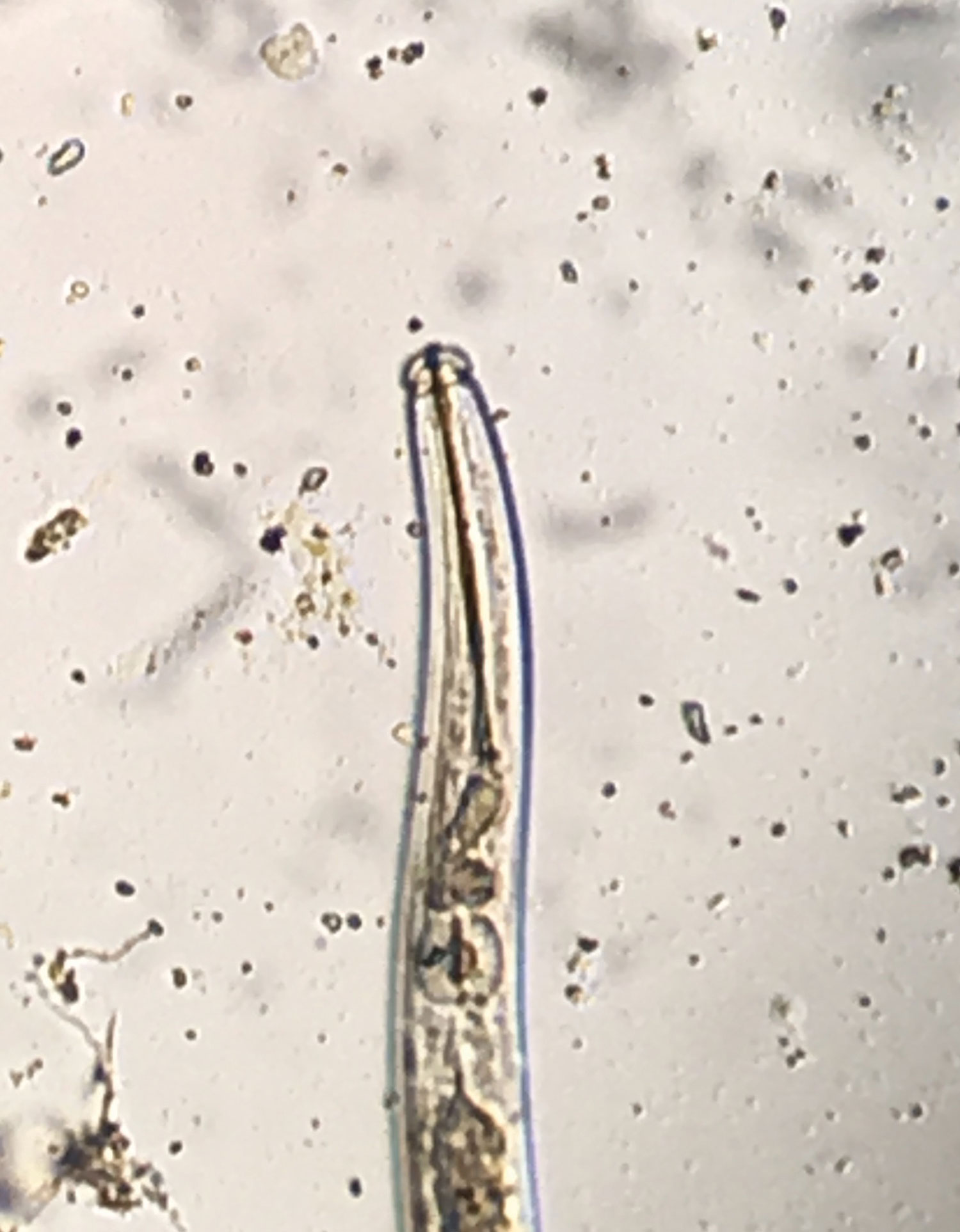
Sting nematode has a long stylet that allows it to feed deep within root tissues. (Photo: Bruce Martin)
February: Taking a look at a new option for nematode management in turfgrass
By Will L. Groover, Ph.D., and Kathy S. Lawrence, Ph.D.
- The experiment evaluated a new nematicide, fluazaindolizine (Reklemel active), for its ability to reduce plant parasitic nematode population density and improve turfgrass quality.
- Separate research trials were conducted on bermudagrass infested with root-knot (Meloidogyne incognita) and sting (Belonolaimus longicaudatus) nematode in field settings over 2018 and 2019.
- Field trials demonstrated a significant reduction for both sting and root-knot nematode population density by multiple rates of Reklemel.
- No significant differences for both visual turfgrass quality ratings and NDVI, but population declines reduced sting and root-knot numbers below the standard 10 and 80 per 100 cm3 of soil.
- Overall, Reklemel shows promise as a nematicide for plant-parasitic nematode management on turfgrass.
March: New soil tests examine fairway responsiveness to nitrogen fertilization
By Karl Guillard, Ph.D., Brendan Noons, M.S., and John Inguagiato, Ph.D.
- Compost and organic fertilizer rates have produced a wide range of the Soil CO2-Burst (CO2B) and Soil Labile Amino Nitrogen (SLAN) test concentrations in fairway creeping bentgrass plots.
- SLAN and CO2B test concentrations respond linearly to compost and organic fertilizer rates.
- Fairway creeping bentgrass growth and quality responses strongly correlate to SLAN and CO2B test concentrations.
- For most variables, trend responses across compost and organic fertilizer rates were generally similar between trafficked and nontrafficked plots.
- Binary logistic regression generated curves to estimate the probability that compost and organic fertilizer rate responses would equal or exceed that of the standard fertilizer treatment.
- The CO2B test produced better binary logistic regression model fits than the SLAN test.
- The CO2B and SLAN tests show potential for estimating the mineralization potential of fairway creeping bentgrass soils.
- The 2021 results suggest the potential categorization of fairway creeping bentgrass soils with Solvita tests as to their probability of equaling or exceeding the response of a standard N treatment.
- The Solvita SLAN and CO2B tests can potentially guide N fertilization of creeping bentgrass fairways.
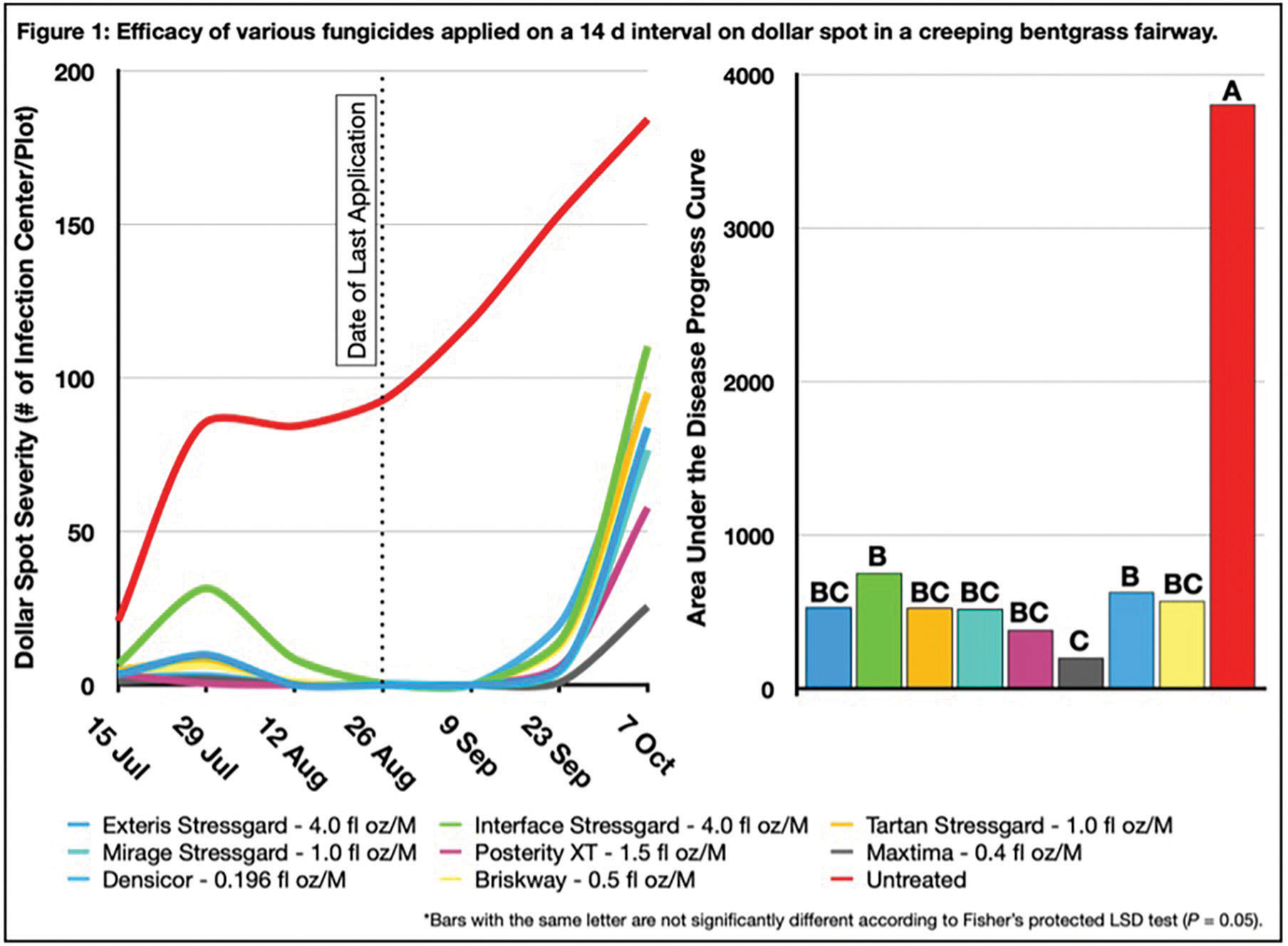
Figure 1
April: Fungicide effectiveness for disease control on creeping bentgrass fairways
By Daniel Earlywine and G.L. Miller, Ph.D.
- Several fungicide products provided adequate control of dollar spot and brown patch on a creeping bentgrass fairway.
- Xzemplar, Naviocn Intrinsic and Maxtima had significantly fewer dollar spot and brown patch than the untreated control.
- Maxtima had fewer dollar spot infection centers than Densicor 4 to 8 weeks after the last application.
- Maxtima and Densicor were applied at 14-day intervals. Densicor was applied at 21 days controlled brown patch.
- All fungicides performed better than the untreated control; however, products provided significantly different levels of control for both dollar spot and brown patch.
- No turf phytotoxicity was observed for products following any application.
May: How a modified TDR affects surface moisture estimation on putting greens
By Daniel O’Brien, Michael Richardson, Ph.D., and Douglas Karcher, Ph.D.
- Portable time domain reflectometry (TDR) meter measurement capabilities can be expanded using spacer blocks.
- Modified TDR meters can estimate volumetric water content (VWC) at new, shallower depths of 0.5 and 1.0 inches.
- Quadratic prediction models provide good estimates of VWC across a range of conditions.
- Linear models tend to overestimate VWC at the lower end of observed values.
- Surface VWC measurements have potential use beyond golf course putting greens.
June: Breaking down the research on cool-season turfgrass water use and needs
By Ross Braun, Ph.D., Dale Bremer, Ph.D., Scott Ebdon, Ph.D., Jack Fry, Ph.D., and Aaron Patton, Ph.D.
- Evapotranspiration and deficit irrigation research in cool-season turfgrasses is summarized.
- Average cool-season turfgrass evapotranspiration rates ranged from 5.35 to 7.79 mm d-1.
- Average cool-season turfgrass crop coefficient rates ranged from 0.85 to 0.95.
- Minimum deficit irrigation replacement levels have ranged from 59 to 74 percent of ET.
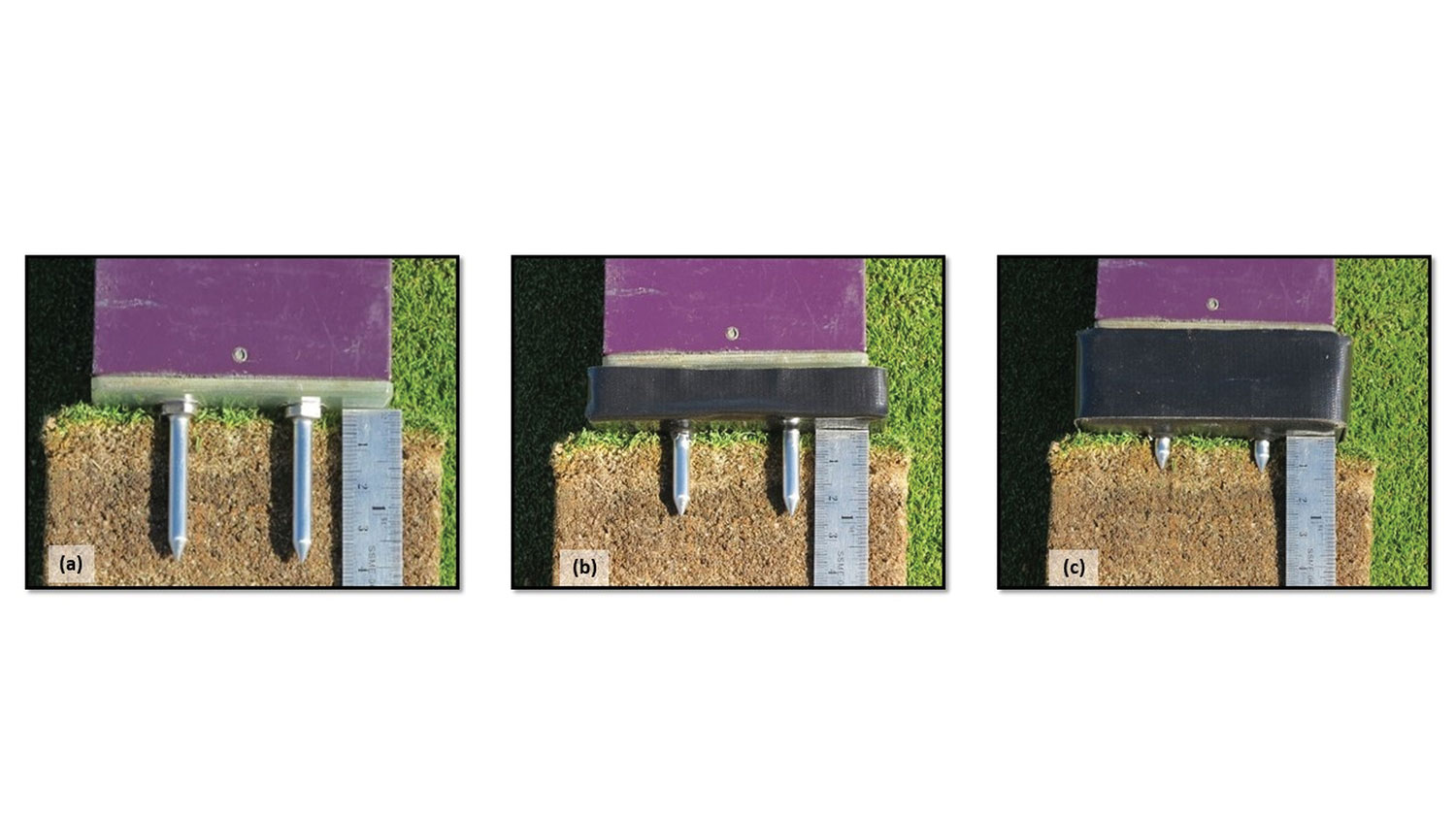
Field Scout TDR300 Soil Moisture Meter and (a) standard 1.5-inch turf rods. Researchers fit spacer blocks (black) onto 1.5-inch rods to achieve new measurement depths of (b) 1 inch and (c) 0.5 inches. (Photo: Daniel O’Brien, Michael Richardson, Ph.D., and Douglas Karcher, Ph.D.)
July: What fungicides control Pythium root rot on creeping bentgrass the best
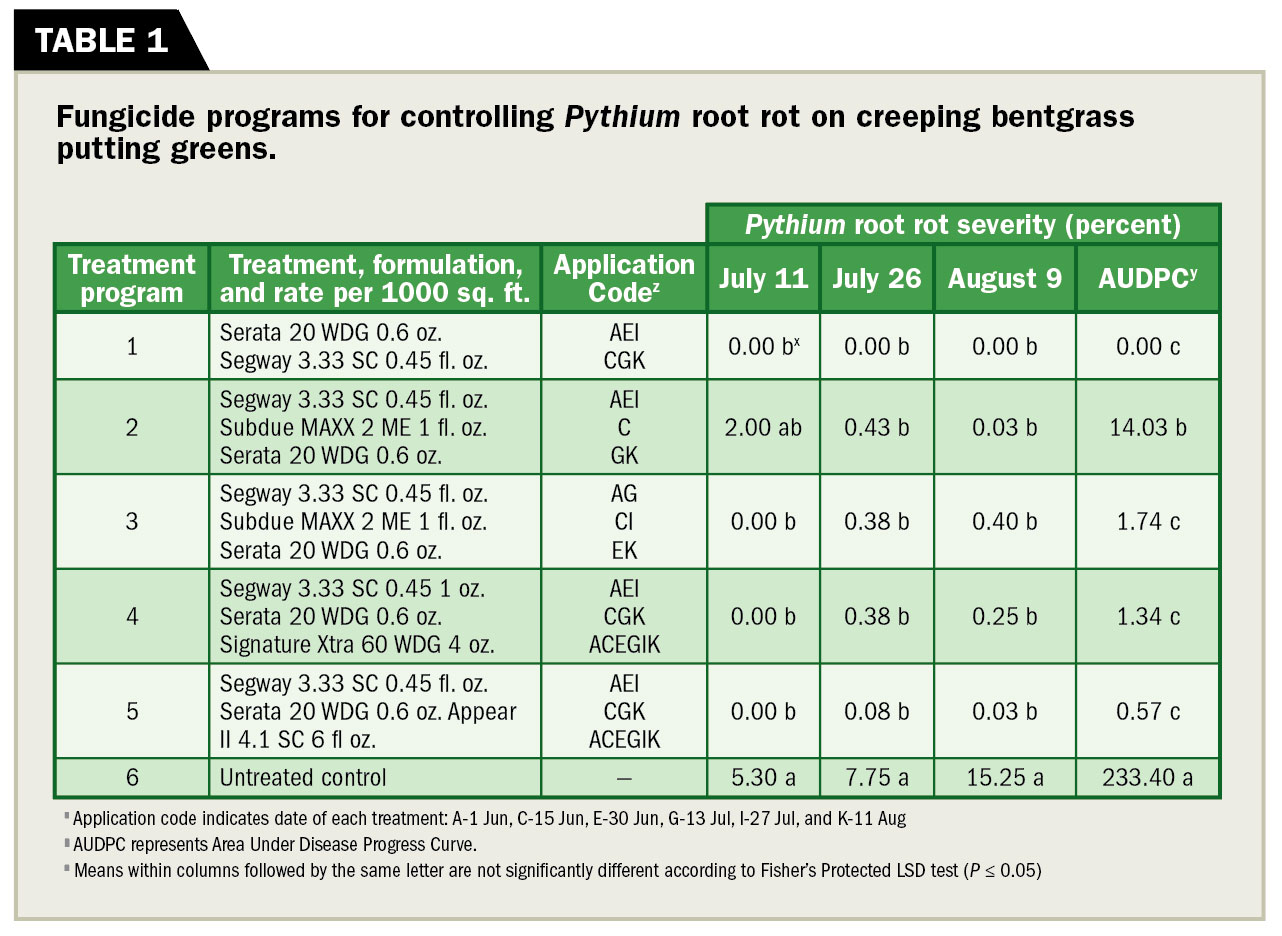 By Jim Kerns, Ph.D., Lee Butler, Jill Ploetz, Daniel Freund, Brandi Merrick and E.C.A. Kitchin
By Jim Kerns, Ph.D., Lee Butler, Jill Ploetz, Daniel Freund, Brandi Merrick and E.C.A. Kitchin
- Serata, Subdue and Segway treatment combinations provided excellent control of Pythium root rot in North Carolina during July and Aug. 2022 compared to the untreated control.
- However, treatment 2 (single application of Subue in June) was significantly worse than treatments 1, 3, 4 and 5, yet still better than the non-treated control (see Table 3).
- Serata alone and in tank mixtures were effective for the preventative and curative control of Pythium root rot (see Tables 3 and 4).
- Results for Serata preventing Pythium root rot were similar to research conducted in South Carolina at Clemson University.
August: Why snow mold hit golf courses so hard last winter
By Paul Koch, Ph.D.
- Early winter rains and heavy spring snow led to significant snow mold development across the northern Great Lakes and the Mountain West.
- Snow mold pressure was much lower on putting greens compared to fairways.
- Climate change may continue to alter the winter environment and make snow mold more difficult to control.
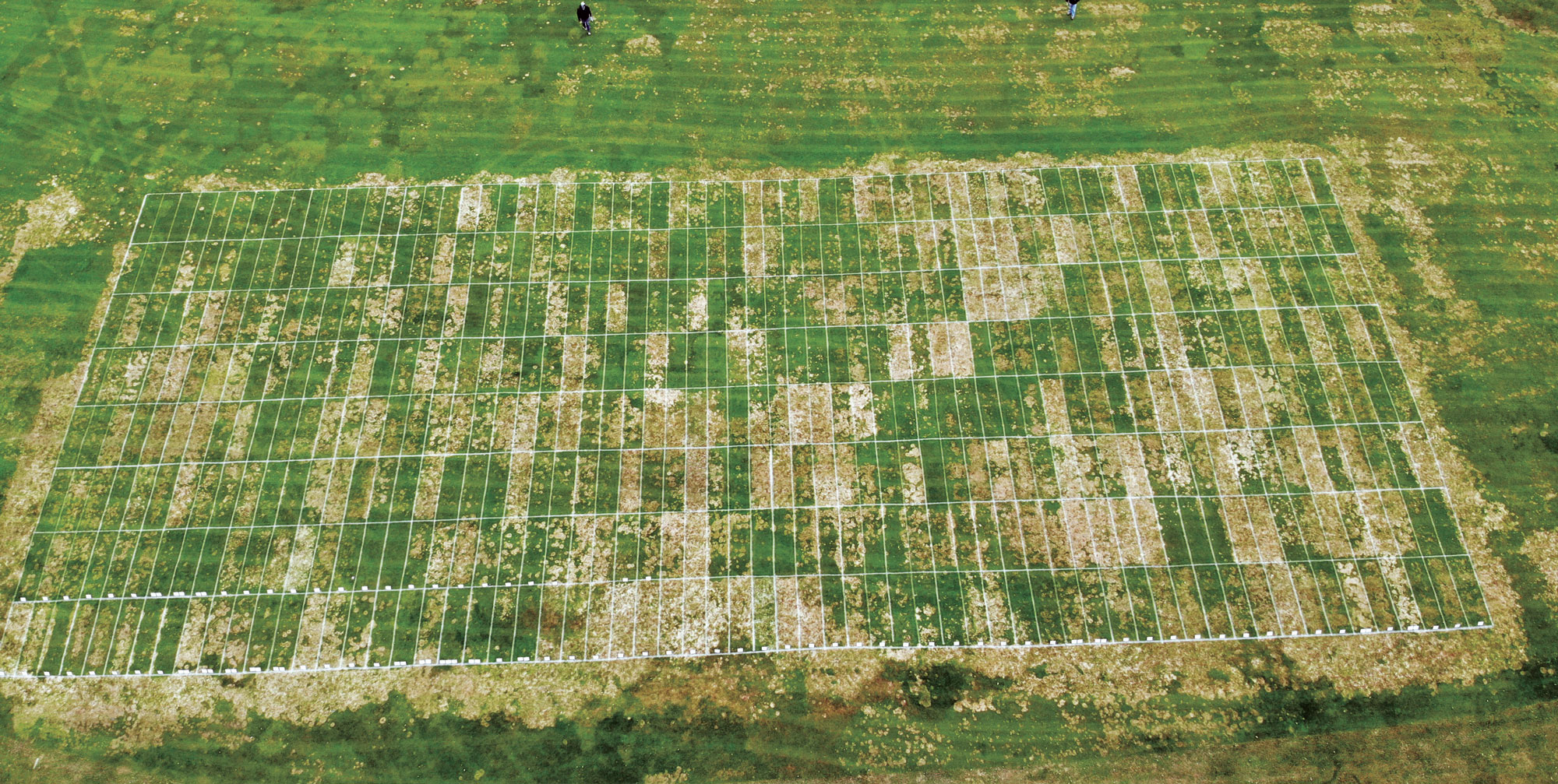
Aerial view of our research trial at Marquette GC in Marquette, Mich. Though there are some green rectangles, there is much more disease breakthrough than we typically experience. (Photo: Tom Steigauf)
September: Fungicide efficacy on spring dead spot-infected bermudagrass
By Jill Ploetz, Lee Butler, C.M. Stephens and Jim Kerns, Ph.D.
- An October and November application of Kabuto 3.3SC at 1.6 fl. oz. per 1000 ft. sq. significantly controlled spring dead spot in bermudagrass.
- Lower Kabuto application rates of 0.75 and 1.2 fl. oz. per 1000 sq. ft. in combination with Tekken 1.8SC at 3.0 fl. oz. provided adequate control.
- Lexicon Intrinsic 4.17 SC at 0.47 fl. oz. and Velista 0.5 WDG at 0.7 fl. oz. per 1000 ft. sq. provided some control; however, both fungicides did not have significantly different AUDPC estimates compared to the non-treated control in 2018.
- Two fall applications of Posterity 1.6SC at the higher rates of 0.32 and 0.24 fl. oz. performed significantly better than the non-treated control.
- In 2019 Velista 0.5 WDG at 0.5 oz per 1000 ft. sq. performed better than the previous fungicide trial in 2018.
- All application rates of both Posterity Forte 2.5SC and Posterity 1.67SC alone and combined with Headway 1.39ME applied at 1.5 fl. oz. per 1000 ft. sq. provided significant control compared to the non-treated control.
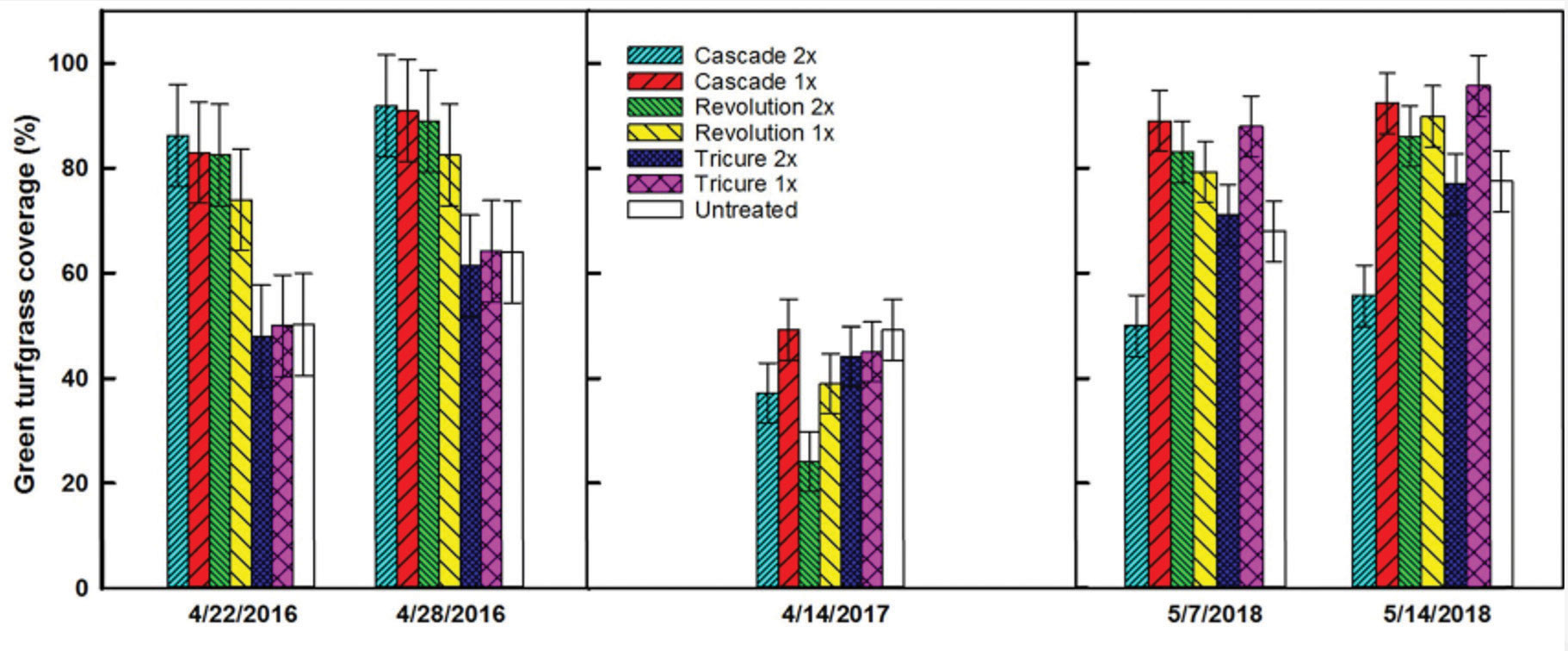
Figure 2
October: Late-Fall Wetting Agent Application and Ultradwarf bermudagrass Winter Survival
By Eric DeBoer, Ph.D., Doug Karcher, Ph.D., John McCalla and Mike Richardson, Ph.D.
- A late-fall wetting agent application may reduce winter injury on bermudagrass putting greens.
- Wetting agents generally reduced hydrophobicity in the top 2 cm of the sand root zone.
- Soil volumetric water content did not differ between treatments on any sampling date throughout the trial.









